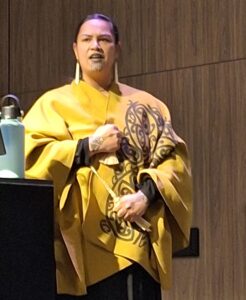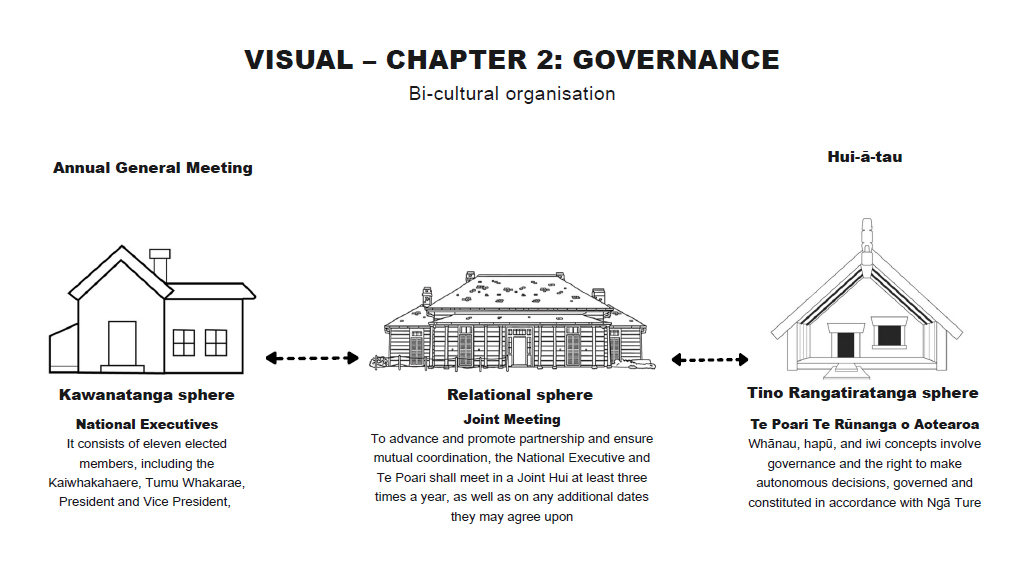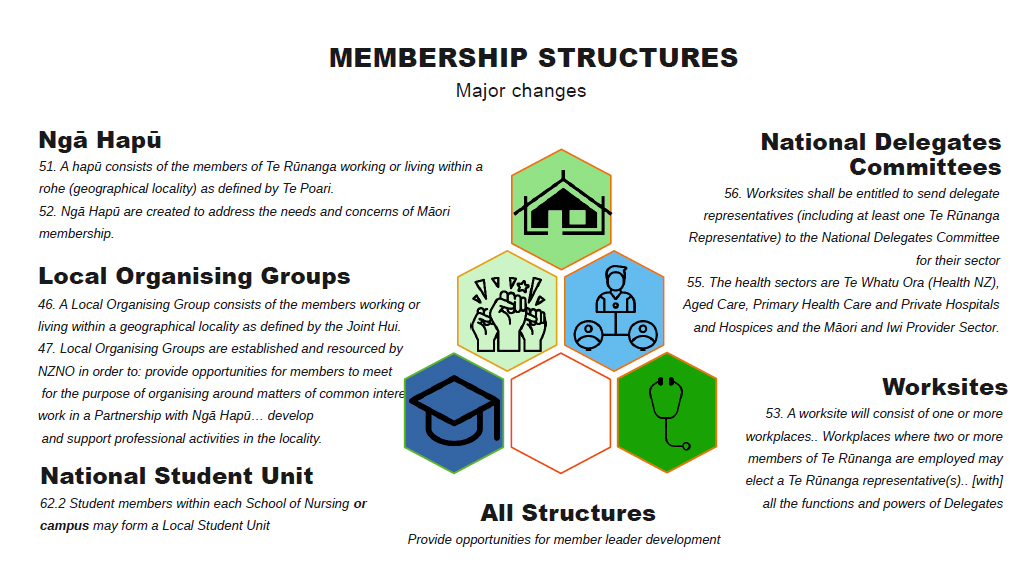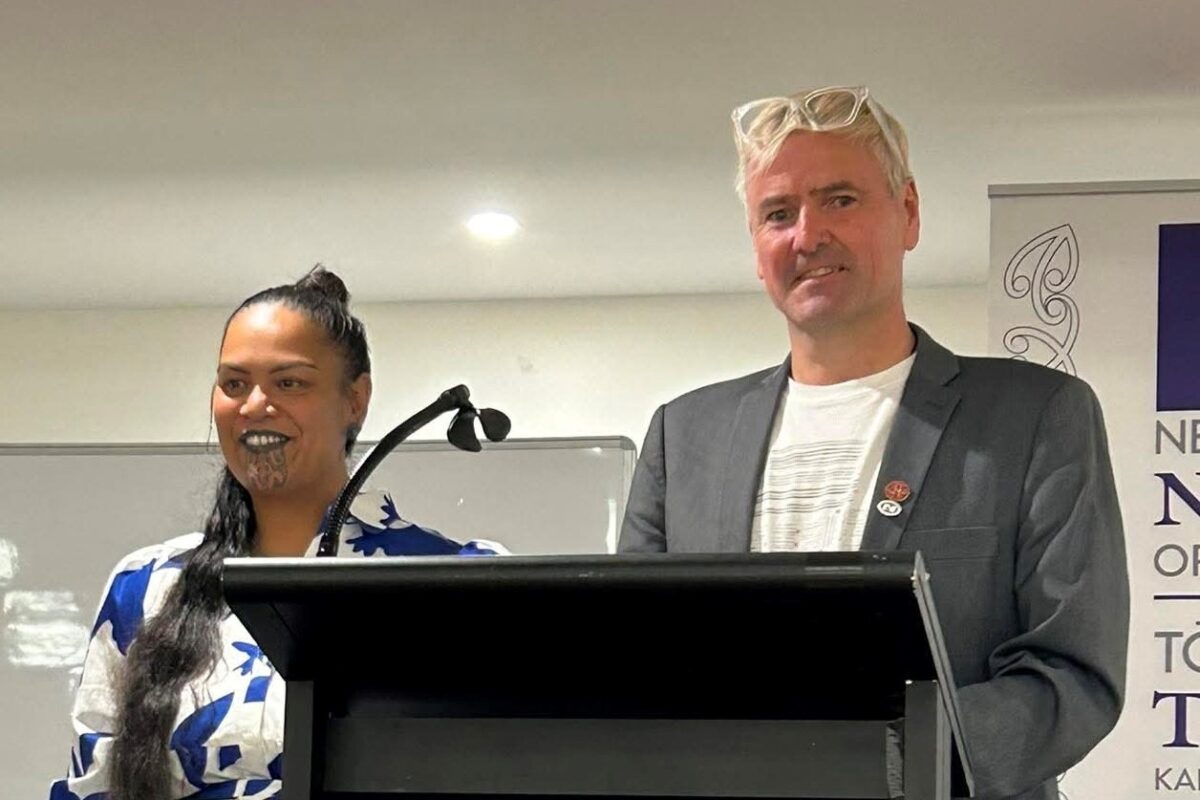Membership committee concerns
Concerns that the new constitution drafting has been rushed, not transparent and not involved enough member consultation were raised at NZNO’s AGM last year by NZNO’s membership committee — which would be disestablished under the changes.
The review panel rejected the claims, saying the review had been underway for five years, undergone three AGM sessions, two member surveys and two member group consultations. The panel had met 30 times, heard from thousands of members and was currently touring the country to publicise the proposed new constitution.
The membership committee also expressed concern that NZNO’s professional side was being sidelined by its union focus — something the panel rejected.
The constitutional review panel (CRP) has said the proposed new constitution is aimed at creating a more unified, te Tiriti-friendly and democratic union for nursing and health-care professionals.
NZNO Māori governance arm Te Poari and member groups have endorsed the draft at special meetings this month — and now it is up to all members to decide, in a ballot from May 20 to June 17.
In the proposal, local member organising groups, working in partnership with local Te Rūnanga representatives in rōpū (groups) called ngā hapū, would replace NZNO’s national membership committee and 11 regional councils.
NZNO’s “hierarchical” chief executive role and board of directors would also disappear, replaced with a national secretary and national executive, to bring it into line with “more egalitarian” union structures, the panel’s presentation to member groups shows.
“Titles given to governance and senior management which reflected an hierarchical culture are replaced in the proposed constitution by more egalitarian union terminology.”

Te Poari ‘equal status’
Te Poari would have equal status with the national executive and would need to approve changes to the constitution, NZNO policies and strategic decisions.
The CRP, which has an equal mix of board and Te Poari members, has been working on the draft since 2020, including consulting with member groups and Te Poari. Its current members are Grant Brookes (board), Kathryn Chapman (Te Poari), Nayda Heays (Te Poari), Isla Taunoa (Te Poari), Nano Tunnicliff (board) and Simon Auty (board). Kathryn Chapman replaced Tracy Black as co-chair late last year.
In its presentation, the panel says while there is currently equal partnership between the president and kaiwhakahaere, “there is not equal partnership between Tōpūtanga Tapuhi Kaitiaki o Aotearoa NZNO and Te Rūnanga o Aotearoa as a whole”.

Drawing on a bicultural model developed by Matike Mai for a new national constitution for Aotearoa, the NZNO proposal would see Te Poari continuing to exercise tino rangatiratanga (self-determination) for its Māori members through its Te Rūnanga arm. The NZNO national executive would govern other members and a partnership body of both called the “joint hui” would meet at least three times yearly to make shared decisions on major issues.

Similar te Tiriti obligations were also reflected in proposed new membership structures.
Local organising groups (LOGs) would replace regional councils, with less focus on administration and more on taking action (as per NZNO strategy Maranga Mai!) and would be required to work in partnership with ngā hapū.
In time, there would be a Te Rūnanga member alongside delegates in every workplace and on all college and section committees. Colleges and sections would continue under the current rules.
National delegates committees would be established across all health sectors to build member activism and leadership in a nationally coordinated manner.

Other proposed changes include:
- NZNO student representation on each campus, rather than each nursing school, as some schools had multiple campuses.
- Five-yearly reviews of the constitution with processes to ensure member voice.
- A new two-stage process on policy changes (remits) would combine member voting with delegate decision-making. Remits would need to pass through hui-a-tau and AGM before they go to members.
- NZNO’s full name — Tōpūtanga Tapuhi Kaitiaki o Aotearoa NZNO — would be enshrined in the new constitution.
- For new or returning members, direct debits would replace “time-consuming” salary deductions for NZNO fees.
- A less punitive, more restorative approach to member disputes.
- Members who belong to other unions — mainly nurse researchers, public health and mental health nurses who have no other option in some areas — would be able to fully participate in their college or section.

Matike Mai
The draft constitution draws on the Matike Mai report on constitutional transformation, which had wide support among Māori and constitutional experts. Also, its late lead author Moana Jackson had a close relationship with Te Poari.
Matike Mai Aotearoa began working on an inclusive constitution for Aotearoa in 2010, exploring various models that enable Māori representation. Its aim is for “constitutional transformation” by 2040.
New term limits for elected NZNO leaders
Other proposed changes include a limit of two three-year terms for all elected leaders. The kaiwhakahaere and tumu whakarae — who are elected by NZNO’s Te Rūnanga members — currently have no term limits.
In the new constitution, they would have the same limits as the president and vice-president, who can only serve two three-year concurrent terms or four terms in a combination of roles. After a two-year break, members can stand again for any role.
This was intended to support new leadership, the panel said in its presentation.
“Term limits . . . should be set . . . so that they each understand their stewardship role, as custodians serving on behalf of the membership for a limited time only, and to support the development of new, emerging leaders.”
Panel member Grant Brookes has been travelling around the country to discuss the proposed new constitution in NZNO member forums such as the college and section new member induction day, the membership committee, Te Tai Tonga Southern regional convention and Waitaha Canterbury regional convention.
New mission, values and objectives
- A new mission focuses on equitable health outcomes and co-governance with NZNO’s Māori membership network Te Rūnanga o Aotearoa.
- New objectives include promoting te Tiriti partnership, the interests of nursing, unions, the rights of indigenous peoples and kaupapa-informed care.
- New values of wairuatanga, whanaungatanga, manaakitanga, ōritetanga, kotahitanga, ukaipōtanga and pūkengatanga must guide members.
Background:
Members voted for a full and independent review of the NZNO constitution in 2020, seeking better bicultural and democratic processes after a period of leadership division.
This was carried out by law firm Morrison Kent, which presented its findings at the 2022 NZNO AGM.
A constitutional review panel was then set up, comprising NZNO members Grant Brookes and Tracy Black (co-chairs), Simon Auty and Nano Tunnicliff (board representatives) and Kathryn Chapman and Nayda Heays (Te Poari representatives). Former Council of Trade Unions president Ross Wilson and law professor Gordon Anderson provided legal advice. The panel sought member feedback and to ensure the revised constitution would:
- Meet NZNO’s te Tiriti o Waitangi obligations
- Embed democratic processes for members that could work in a bicultural environment
- Give effect to the Maranga Mai! strategy
After the 2023 AGM, the panel began drafting a revised constitution with proposed changes released in March 2024. These were consulted on at regional conventions and member groups. The resulting draft was then discussed at the 2024 AGM and hui-a-tau.
At a special hui-ā-tau on April 4, 2025, Te Poari endorsed the draft new constitution. It was then endorsed at a special NZNO meeting by member groups on April 7 and is to go to an all-member vote.
If members reject the new constitution, Brookes said a special general meeting was likely to be held to endorse the current constitution with some technical amendments to make it compliant with the Incorporated Societies Act 2022.
- NZNO will be holding a series of webinars for members from May 5 to 16 to discuss the proposed new constitution. Voting will take place from May 20 to June 17 and the results announced on June 18, 2025.
- This article was amended on May 21 to clarify that only new members would have their fees taken by direct debit rather than salary deductions; and that the current constitution would need technical amendments to be endorsed if the new one was rejected.



